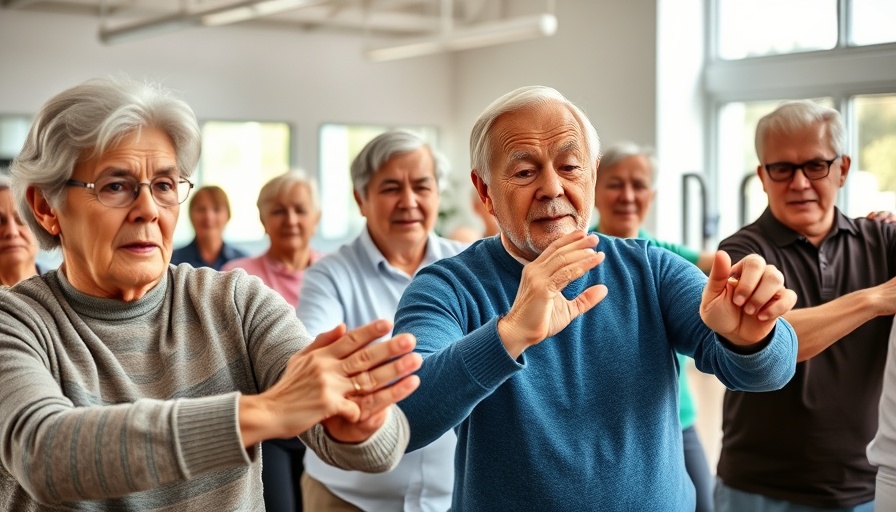
Understanding Grip Strength: A Key to Healthy Aging
Have you ever found yourself dropping your phone or struggling to open a jar? You're not alone. For many middle-aged and seniors, a decline in grip strength can be a frustrating experience. However, it’s vital to recognize that this isn’t merely a sign of aging—it’s often a signal from your body about muscle loss and, potentially, inflammation. As we age, hormonal changes reduce our body's ability to repair muscle fibers effectively, resulting in weakness and fatigue in our hands. Let's delve into why grip strength matters and how we can enhance it.
In 'Stop Dropping Things! 3 Simple Exercises for Better Grip,' the focus is on enhancing grip strength among seniors, prompting deeper exploration into effective strategies that promote healthy aging.
The Science Behind Weak Grip Strength
Research has shown that grip strength can be a predictor of longevity, often more reliable than traditional medical metrics like blood pressure. A Swedish study highlighted that grip strength declines significantly after the age of 67 for men and 72 for women. Moreover, with every 5 kg decrease in grip strength, there’s a 16% increase in mortality risk. Poor grip strength is also linked to higher inflammation rates, which can impede muscle repair and lead to a downward health spiral termed the "silent slip." Understanding these factors is crucial in prioritizing our hand health as we age.
Three Effective Exercises to Regain Your Grip
If you've ever felt defeated by your hands, don't fret—regaining grip strength is absolutely achievable and can even restore your confidence in everyday tasks. Here are three exercises that have proven effective:
Tennis Ball Squeeze
Simply hold a tennis ball (or a stress ball) in one hand and squeeze it tightly for 3 to 5 seconds, then release. Aim for 10 repetitions per hand, ensuring you do two sets. As you gain strength, gradually switch to even firmer balls. This simple exercise serves as a cue for your muscles to awaken and start rebuilding.
Hand Exerciser Training
Using a hand exerciser, apply controlled tension. Squeeze for 2 seconds, then release for one. Complete 15 reps per hand for three sets, three times a week. This method builds muscle endurance over time without putting additional strain on your tendons and ligaments.
Finger Extensions with Rubber Band
Wrap a rubber band around your fingers and gently try to spread them apart. Hold this position for two seconds and relax. Repeat this for 10 to 12 reps over two to three sets each day. By focusing on the extensor muscles, you’re working to balance your grip strength and prevent stiffness.
The Role of Nutrition in Strengthening Grip
While exercise is vital for grip strength recovery, nutrition plays an equally important role. Your body needs the right nutrients to rebuild muscle effectively. Focus on incorporating protein-rich foods evenly throughout the day, ideally aiming for 20-25 grams per meal. Eggs, fish, and legumes can be beneficial. Additionally, consider anti-inflammatory foods, like omega-3 fatty acids, that help remediate inflammation while protecting muscle integrity.
Empowering Independence through Stronger Hands
Embracing a routine that includes these exercises and nutritional strategies can be transformative. Imagine how liberating it would be to easily open jars and confidently hold your loved ones' hands. This is not just about physical health; it's about restoring your sense of independence and confidence. As you embark on this journey, remember that small, consistent efforts can lead to remarkable changes in your grip strength—and overall well-being.
The Hidden Benefits of Grip Strength Training
Beyond the physical improvements, there are psychological benefits linked to enhanced grip strength. Studies suggest that increased muscle power can contribute to improved mental sharpness and decreased risk of depression among seniors. When we feel strong and capable, our mental resilience often improves, allowing us to face the challenges of aging with grace.
Taking Action for a Better Tomorrow
As we explore the long-term impact of these exercises and lifestyle changes, it’s essential to view this not just as a physical challenge but as a holistic journey toward better aging. Share your experiences and strategies with others to create a supportive community. What small changes will you make today to enhance your grip strength?
Remember, this guidance is not medical advice, but a way to inspire action toward fostering healthy aging for seniors. Every small step you take contributes to a larger goal of reclaiming your strength and independence.
 Add Element
Add Element  Add Row
Add Row 




Write A Comment